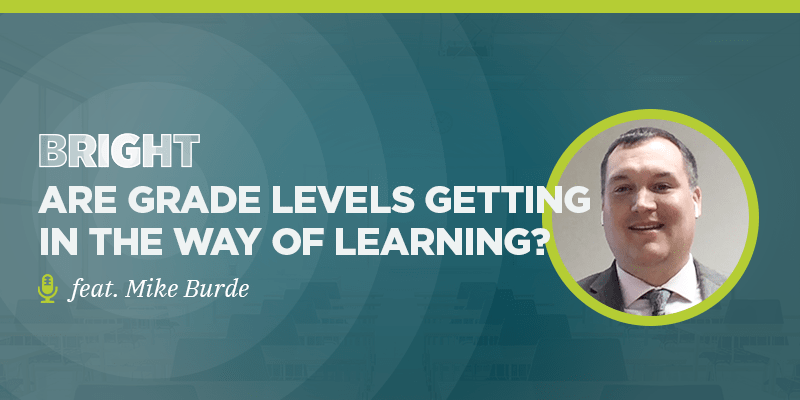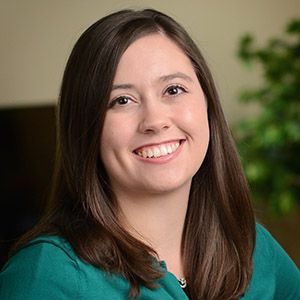What if there’s something better than “grade levels” to frame how students progress through the K-12 curriculum?
What if rather than basing academic progression on a student’s age, we instead focused on what they know and can do?
Mike Burde is an assistant superintendent at Kenowa Hills Public Schools, where they have, as a district, embraced a concept they call “personal mastery” in learning.
This means that rather than advancing based on time in a particular grade level, students advance only after they’ve mastered the content of the class.
This approach stands in contrast to a more traditional “time-based model of advancement” — which many of us are probably familiar with and where all students learn at the same pace in grade bands.
The idea is: By mastering basic topics before moving onto more complex ones, students are less likely to fall behind their peers as lessons increase in difficulty. It’s a way to ensure that all students can succeed, not just some or most.
Empowered by this mission of learning for all, Kenowa Hills has become one of the earliest adopters of competency-based education in Michigan and hopes to leverage this innovative approach to learning to eliminate gaps that can easily accumulate in the traditional model.
To accomplish this, they’ve begun implementing Marzano’s concept of high-reliability schools, which was developed by Dr. Robert Marzano and is the synthesis of 40 years of educational research. What resulted was a school-wide framework with five levels that schools can work toward to create competency-based learning for all students.
The vision that Burde posits is one where students can demonstrate and master transferable skills at their own pace. He dreams of having students be able to leave Kenowa Hills with a “21st-century transcript” that outlines and provides evidence for the skills a student has mastered during their time in school.
But there’s a lot of work required to build a system like this, and you can’t rush this work, Burde says.
According to Marzano’s research, some fundamental pieces need to be in place for such a system to thrive, such as, first and foremost, having a safe, supportive, and collaborative school culture.
Throughout our conversation, we explored Burde’s vision for learning, the roots of our current education system, and how they’re working at Kenowa Hills to move toward “personal mastery” for all students.
A vision for learning developed from childhood
Both of Burde’s parents were educators. His father was a superintendent, and his mother was a middle school teacher, and both shaped his views on education at a very young age.
“All students succeeding is kind of common lingo in education now,” he says, “but hearing those words was commonplace in my home. We had some great dialogue in the house when I was growing up. I got to see how transformative education was in my dad’s own life and how it served as a pathway for him out of a pretty challenging situation.”
He credits his current vision for student learning to these early childhood experiences.
And what is his vision?
“The reality is,” Burde explains, “as a state and nation, we need all of our learners to be successful. Not most. Not 99%. We need all of them to be successful.”
“My vision for education,” he continues, “is one where we transform into a system where we can ensure all students’ success and where we lift up students’ interests, passions, and areas where they’re talented. We let them explore those in authentic ways, and we give them a pathway where they can leave our care confidently knowing the next step in their life.”
What this looks like in practice is shifting away from academic progression based on time spent to one based on what students know and can do (i.e., competency-based).
“I think too often the traditional system was designed for the middle.”
“I think too often the traditional system was designed for the middle,” Burde says, “you know, students in the 25th to 75th percentile. But it missed the students in the 75th to 100 percentile and those in the 1st through the 25th. We’ve designed for the middle instead of designing for all. However, if we flip this upside down by getting away from this notion of grade levels and instead focusing on designing for the individual learner’s needs, I think we can transform and accomplish our vision of ensuring all students are successful.”
See also: Competency-Based Progression: Designed for Student Success
Marzano’s concept of high-reliability schools
One thinker who has been influential to Burde is Dr. Robert Marzano.
Marzano’s framework for “high-reliability schools” takes its inspiration from industries like nuclear energy and air traffic control, where failure is not an option.
This innovative framework takes the criteria for “high reliability” in business and translates these concepts to schools where advocates argue that similarly, failure should be considered acceptable given the import of the profession in shaping young minds.
There are five levels to Marzano’s framework.
The idea here is that the first three levels are foundational, which means schools need 1) a safe, supportive, and collaborative culture, 2) effective teaching in every classroom, and 3) a guaranteed and viable curriculum to implement levels 4 and 5 with any degree of efficacy (see Figure 1 below).
Figure 1: High-reliability schools framework from Marzano Resources
Levels 4 and 5 are, respectively, standards-based reporting and competency-based education.
Since meeting Marzano in Colorado and undergoing training in this framework, leadership at Kenowa Hills has been developing iterative plans at both the building and district-level to design goals and action steps for each of these five levels.
To get started, they’ve been highly intentional about cultivating a safe, supportive, and collaborative culture at their schools in Kenowa Hills.
A few initiatives that are underway toward this goal include:
- Greeting students at the door each morning
- Having students create “social contracts”
- Starting each morning with good news and celebrations
- Focusing on diversity, belonging, and inclusion
The work of creating a safe, supportive, and collaborative culture, Burde says, is ongoing.
“It’s not a checklist. You’re never, as a school or district, going to check off school culture and say you finally arrived. The reality is, culture and climate is something you need to continuously grow and improve upon.”
“It’s not a checklist,” he says. “You’re never, as a school or district, going to check off school culture and say you finally arrived. The reality is, culture and climate is something you need to continuously grow and improve upon.”
Designing 21st-century transcripts
Part of shifting toward a competency-based model for learning is defining what skills and dispositions matter most.
At Kenowa Hills, they’ve been working on building out their “Profile of a Graduate,” which focuses on five skills and dispositions that they believe are essential for college and career readiness.
They want students to leave their care being:
- An Empowered Learner
- A Complex Thinker & Problem-Solver
- A Responsible Collaborator
- An Impactful Citizen, and
- A Skilled Communicator
“We’re trying to emphasize that learning is a lifelong adventure. We all learn while we’re on the earth, that’s how we are as humans, so we want students to feel empowered in their learning that they have agency and control over this process.”
“Regardless of whether a student is college- or career-bound,” Burde explains, “we feel like these skills and dispositions are essential. We want them to be a responsible collaborator, someone who works well with others in teams. We want them to be impactful citizens, so when they leave our care, they’re equipped to be world-changers. We want skilled communicators as well as complex thinkers and problem-solvers. And then last, we want empowered learners. We’re trying to emphasize that learning is a lifelong adventure. We all learn while we’re on the earth, that’s how we are as humans, so we want students to feel empowered in their learning that they have agency and control over this process.”
One of Burde’s dreams is to have students leave Kenowa Hills with what he calls a “21st-century transcript” that offers a portfolio of evidence related to each of these skills.
“What if we could create a digital portfolio,” he asks, “where our learners could accumulate evidence and artifacts of them being a complex problem-solver over their time with us? So once students leave our care, they can go to college or a career and say, ‘Let me show you how I am a complex problem solver. Let me show you how I am a good teammate and a responsible collaborator.’”
That’s the dream. Though Kenowa Hills isn’t quite there yet, they’re working their way up Marzano’s five levels in a sustainable and effective manner.
See also: What’s Best for Kids
The difference between ‘learning loss’ and ‘schooling loss’
Reflecting on the COVID-19 pandemic and its effect on education, Burde pointed out that there’s a significant difference between ‘learning loss’ and ‘schooling loss’ that ought to be considered as we move forward.
“I don’t believe our students have encountered learning loss,” he says. “What they’ve encountered is a pandemic, and the result of the pandemic has been schooling loss. And that’s much different than learning loss.”
See also: Stop calling it “learning loss”
To address the vast array of student needs resulting from pandemic learning conditions, Burde says our best bet is to embrace competency-based education.
“If we don’t apply some of what we know about competency-based education, I think we’re going to experience some struggles. It’s not a one-size-fits-all solution. This gets to the heart of what competency-based education is about. It’s about each and every student and what they need.”
“If we don’t apply some of what we know about competency-based education,” he says, “I think we’re going to experience some struggles. It’s not a one-size-fits-all solution. This gets to the heart of what competency-based education is about. It’s about each and every student and what they need.”
As we move forward, there are many questions worth considering here: How can we shift away from a system of academic progression based on grade level and toward one that revolves around personal mastery? How can we target students’ individual needs at scale?
Without a doubt, it’s going to be hard work. But with leaders like Burde forging our path forward, if there’s one thing we’re certain: it’s that the future is bright.
Additional resources
Marzano High-Reliability Schools (HRS) framework

